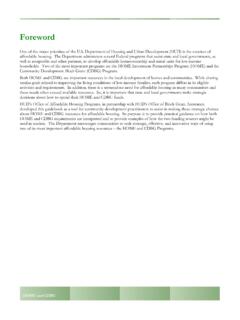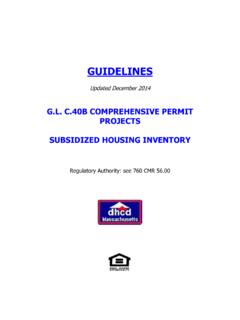Transcription of The “Double Trouble” of the Housing Market
1 The Double Trouble of the Housing Market February 2022. National Association of REALTORS Research Group Lawrence Yun, Chief Economist and Senior Vice President, NAR. Jessica Lautz, Dr. of Real Estate Vice President, Demographics and Behavioral Insights, NAR. Nadia Evangelou Senior Economist, Director of Forecasting, NAR. Meredith Dunn Research Manager, NAR. Danielle Hale Chief Economist, NAR Research and Sabrina Speianu Economic Data Manager, Staff 2022 National Association of REALTORS . All Rights Reserved. May not be reprinted in whole or in part without permission of the National Association of REALTORS . For reprint information, contact 2022 The Double Trouble of the Housing Market Introduction 4. National Comparison of Affordability to Pre-Pandemic Levels 6. Local Comparison of Affordability to Pre-Pandemic Levels 8. Affordability by Race 10.
2 Table of Contents Appendix 14. Methodology 17. 2022 The Double Trouble of the Housing Market Introduction Two in three renters cannot afford to buy a home; one in two Specifically, this analysis differs from previous research and renters pay more than 30 percent of their income for rent due to measures on affordability: rising rental costs. a. It considers affordability for all income percentiles, not just And it's getting worse. Home prices continue to rise to record median income. highs, eroding affordability even further. Since 2019, home prices While looking at the median family income is a good rose nearly 30 percent. As a result, a typical home is about $80,000 representation of the middle of the Market , the situation for those more expensive than pre-pandemic. Wages may have also with incomes above or below the median family income can look increased but not anywhere near the pace of the home prices.
3 This quite different. means that potential buyers need to spend more of their budget on Housing in order to buy the typical home now compared to b. It looks at affordability of active inventory or homes currently 2019. available for sale instead of homes that have already sold. Thus, these are real-time listings. Meanwhile, inventory of homes for sale dropped significantly in the last couple of years, reaching record lows in 2021. In fact, there Most affordability indexes use home sales prices to determine was a Housing shortage even before the pandemic hit in 2020. Housing affordability, so they are backward-looking. Using active There are currently only around 1 million units available for sale inventory, we know what is affordable among homes currently compared to near 4 million homes available for sale in 20071. This available for buyers to put an offer on.
4 Translates to fewer options for homebuyers leading to multiple c. It connects the two troubles of the Housing Market . offers and competition in the Housing Market . Rising prices erode affordability. Nevertheless, low inventory So, two troubles are happening simultaneously: record high makes it even more difficult for homebuyers to purchase a home home prices and record low inventory. NAR Research and as there are significantly fewer homes that they can afford to buy. partnered to do an analysis of affordability at different income levels for all active inventory on the Market . 1 Inventory data in this statement are sourced from the National Association of REALTORS . Specifically, this report looks at this dual phenomenon across the as the data has a long history which goes back to 1999. In other sections of the analysis, inventory data is sourced from which has a shorter data history but more country and the 100 largest metro areas, comparing the number of granular local data.
5 At the national level, inventory data shows a smaller total, available homes that people at any income level can afford to buy roughly half a million listings compared with NAR's roughly 1 million listings. Differences in methodology stemming from classification of active or unsold homes as well as timing of now and pre-pandemic. Connecting affordability with currently the estimates largely account for the difference. Despite the different levels in the data available Housing supply is what makes this analysis unique. series, the data tends to trend similarly over time. 2022 The Double Trouble of the Housing Market 4. Affordability 2022 The Double Trouble of the Housing Market Comparison to Pre-Pandemic Affordability: National Nationwide, Housing affordability declined compared to pre- income bracket $75,000 to $100,000 but only 245,300 currently pandemic conditions.
6 Although mortgage rates are still lower than listed homes that they can afford to buy. This means that there is in 2019, home prices are more than 30% higher now. Over the same only one listing available for every 65 households of that income period, wages rose 12%. As a result, the analysis found that: group. This is a stark decrease in availability from one listing for A household earning $75,000 to $100,000 can currently afford to every 24 households in 2019. buy 51% of the active Housing inventory. Nevertheless, that same See the table on the next page to see how the double trouble . household could afford to buy 58% of the homes for sale in 2019. impacted households in other income groups. The most impacted Thus, during the pandemic, affordability2 for households in households are those earning $50,000 to $75,000. For this income the income bracket $75,000-$100,000 dropped by 7 group, affordability dropped by 6 percentage points while there are percentage points.
7 63% fewer active listings that they can afford to buy. At the end of In the meantime, inventory plunged to a historic low during the 2021, households earning $50,000 to $75,000 were able to afford pandemic. In fact, there is 57% less inventory now than in 2019. Not nearly 165,280 listings compared to 450,220 at the end of 2019. With only can people can afford fewer homes due to lower affordability, fewer homes in the entry level, the double trouble was expected their options are limited even further as there are significantly fewer to have a higher impact in the lower income levels. As income homes available for sale. Thus, the analysis also found: increases, the impact decreases. There are about 245,300 homes currently listed for sale that a household earning $75,000 to $100,000 can afford to buy. By 2 Affordability in this instance is measured as the percent of homes that are actively for comparison, there were 656,200 available homes for that same sale that can be purchased by the household.
8 A home is deemed affordable if the household pre-pandemic. Thus, due to the double trouble , household is spending no more than 30% of their income on the Housing costs, which include principal, interest, insurance, and taxes. there are nearly 411,000 fewer homes available for sale for this household compared to pre-pandemic. It's even more interesting when we compare the number of households in each income bracket with the affordable listings. That way we see the number of households per listing. It's estimated that there are about million households in the 2022 The Double Trouble of the Housing Market 6. 2021 2019. Share of Number of Number of Share of Number of Number of listings that listings that households listings each listings that households Income Level each each per listing household each per listing household household can afford to household can can afford can afford to buy afford to buy to buy buy Less than $15,000 4% 17,398 761 4% 47,273 282.
9 $15,000-$24,999 6% 29,721 341 7% 80,477 129. $25,000-$34,999 12% 58,717 175 13% 151,387 69. $35,000-$49,999 20% 98,586 149 23% 260,004 58. $50,000-$74,499 34% 165,277 125 40% 450,223 46. $75,000-$99,999 51% 245,257 65 58% 656,200 24. $100,000-$124,999 63% 306,632 36 71% 796,332 14. $125,000-$149,999 72% 349,885 22 78% 882,999 9. $150,000-$199,999 80% 387,338 24 85% 953,910 9. $200,000-$249,999 86% 415,609 10 90% 1,011,313 4. $250,000-$499,999 91% 441,222 11 94% 1,060,275 4. $500,000+ 100% 483,266 3 100% 1,125,557 1. 2022 The Double Trouble of the Housing Market 7. Comparison to Pre-Pandemic Affordability: Local At a local level, it's quite surprising to see that very expensive After comparing the number of affordable listings among the areas such as San Francisco, CA; San Jose, CA; Honolulu, HI; and 100 largest metro areas, the National Association of Washington, DC are currently more affordable compared to REALTORS and were able to identify the top 10.
10 Pre-pandemic. How can these areas be more affordable ? Home areas with the most available homes for sale relative to the prices have increased but higher incomes coupled with lower household population by income level. For instance, if your mortgage rates seem to have eased affordability in these areas. income is in the range of $75,000 to $100,000, Deltona, FL; Des For example, the income of the typical household rose by 15% Moines, IA; and Augusta, GA-SC are the top 3 areas for this in San Jose, CA in the last 2 years. Respectively, the typical income group with a listing per nearly 30 households. household income is 13% higher in San Francisco, CA compared to 2019. Meanwhile, remember that in the first year of the pandemic, many people were fleeing away from these big and expensive areas, so home prices were rising slower there compared to other areas during that time.













